HTML
--> --> -->The explicit chiral-symmetry breaking in QCD is assumed to contribute to the masses of the elementary particles [2-4]. In QCD-like models, which incorporate some features of QCD so that they are able to give an approximate picture of what the first-principle lattice QCD simulations can lead to, such as the Polyakov linear-sigma model (PLSM), or the Polyakov quark-meson (PQM) and the Polyakov Nambu-Jona Lasinio (PNJL) models, some properties of the QCD meson sectors can be studied numerically. In the present paper, we study the chiral phase-structure of sixteen meson states in a finite magnetic field and its dependence on temperature and chemical potential. To characterize the dependence of various meson masses for pseudoscalars (
It is not only the peripheral heavy-ion collisions that generate enormous magnetic fields, but also the central ones as well. Due to the opposite direction of relativistic charges (spectators), especially in non-central collisions and/or due to local momentum imbalance of the participants, a huge short lived magnetic field can be created. At SPS, RHIC and LHC energies, for instance, the mean values of such magnetic field have been estimated as ~0.1, ~1, and ~15
It is noteworthy to highlight the remarkable influence of the Polyakov-loop potentials on scalar and pseudoscalar meson sectors. With the in (ex) clusion of the Polyakov-loop potentials in the LSM Lagrangian, the chiral phase-structure of the nonet meson states for finite temperatures has been evaluated [8]. The same study was carried out with(out) axial anomaly term [9, 10]. A systematic study of the thermal (temperature) and dense (chemical potential) influence on the chiral phase-structures of the nonet (sixteen) meson states with (out) axial anomaly term, and also with in (ex) clusion of the Polyakov-loop potentials, was published in [11]. For the sake of completeness, we recall that for finite chemical potential the SU(3) NJL model [12] and the SU(3) PNJL model [13-15] have been applied to characterize the nonet meson states as well.
The present work represents an extension of Ref. [11] to a finite magnetic field. We present a systematic study of the influence of the finite magnetic field, which is likely to be present in high-energy collisions, and the possible modifications on the chiral phase-structure of various (sixteen) mesonic states, including (pseudo) scalar and (axial) vector meson sectors, as function of temperature and chemical potential in the presence of a finite magnetic field. The temperature and chemical potential dependence of the chiral nonstrange and strange quark condensates,
An extensive comparison of our calculations of the meson nonets with the latest compilation of the Particle Data Group (PDG), lattice QCD calculations, and QMD/UrQMD simulations, shall be presented. It allows not only to characterize the meson spectra in thermal and dense medium, but also to describe their vacuum phenomenology in finite magnetic fields. We conclude that the results obtained are remarkably precise, especially for some light mesons, if these are extrapolated to vanishing temperatures.
The paper is organized as follows. We briefly describe the chiral LSM Lagrangian with three quark flavors in Section 2.1. We then give a short reminder of the PLSM model in the mean-field approximation in Section 2.2. In a vanishing or a finite magnetic field, the dependence of chiral nonstrange and strange quark condensates, and the corresponding deconfinement order-parameters characterizing the quark-hadron phase transition, on temperature and chemical potential, calculated form the SU(3) PLSM model, is presented in Section 3.1. The characterization of the magnetic catalysis is discussed as well. The chiral phase-structure of the various meson states in a finite magnetic field is outlined in Section 3.2. The temperature dependence of the chiral phase-structure of the sixteen meson states in a finite magnetic field is analyzed in Section 3.2.1. The chemical potential dependence is introduced in Section 3.2.2. Section 3.2.3 is devoted to the temperature dependence of these meson states normalized to the lowest Matsubara frequency. The conclusions are given in Section 4.
2
2.1.Lagrangian of the linear-sigma model
As introduced in previous sections, LSM seems to give a remarkably good description of various meson states. With the increasing number of degrees of freedom, the quark flavors● the first term represents quark (q) and antiquark fields (
$ {\cal{L}}_{f} =\bar{q} \left[i {\partial\!\!\!\!/}-g T_a \left(\sigma_a + i \gamma_5 \pi_a + \gamma _{\zeta} V_a ^{\zeta}+\gamma _{\zeta}\gamma _{5} A_a ^{\zeta} \right) \right] q, $  | (1) |
● the second term gives the mesonic Lagrangian, which consists of the various contributions of the nonet states, interactions and possible anomalies
$ \begin{aligned} {\cal{L}}_{m}&=&{\cal{L}}_{\rm SP}+ {\cal{L}}_{\rm VA}+ {\cal {L}}_{\rm Int}+ {\cal{L}}_{U(1)_A}, \end{aligned} $  | (2) |
$ \begin{split} {\cal{L}}_{\rm SP}=& {\rm{Tr}}\left[(D^{\mu}\Phi)^{\dagger} (D^{\mu}\Phi)-m^2 \Phi^{\dagger} \Phi\right]-\lambda_1 [{\rm{Tr}}(\Phi^{\dagger} \Phi)]^2 \\&-\lambda_2 {\rm{Tr}}(\Phi^{\dagger} \Phi)^2 + {\rm{Tr}}[H(\Phi+\Phi^{\dagger})], \end{split} $  | (3) |
$ \begin{split} {\cal{L}}_{\rm AV}=&-\frac{1}{4}\mathop{{\rm{Tr}}}\left(L_{\mu\nu}^{2}+R_{\mu\nu}^{2} \right)+\mathop{{\rm{Tr}}}\left[\left( \frac{m_{1}^{2}}{2}+\Delta\right) \left(L_{\mu}^{2}+R_{\mu}^{2}\right)\right] +i \frac{g_{2}}{2} (\mathop{{\rm{Tr}}}\{L_{\mu\nu}[L^{\mu}, L^{\nu}]\}+\mathop{{\rm{Tr}}}\{R_{\mu\nu}[R^{\mu}, R^{\nu}]\}){}+ g_{3}[\mathop{{\rm{Tr}}}(L_{\mu}L_{\nu}L^{\mu}L^{\nu} )\\ &+\mathop{{\rm{Tr}}}(R_{\mu}R_{\nu}R^{\mu}R^{\nu})]+g_{4} [\mathop{{\rm{Tr}}}\left( L_{\mu}L^{\mu}L_{\nu}L^{\nu}\right) +\mathop{{\rm{Tr}}}\left( R_{\mu}R^{\mu}R_{\nu}R^{\nu}\right) ]{} +g_{5}\mathop{{\rm{Tr}}}\left( L_{\mu}L^{\mu}\right) \mathop{{\rm{Tr}}}\left( R_{\nu}R^{\nu}\right) +g_{6} [\mathop{{\rm{Tr}}}(L_{\mu}L^{\mu}) \mathop{{\rm{Tr}}}(L_{\nu}L^{\nu })\\&+\mathop{{\rm{Tr}}}(R_{\mu}R^{\mu}) \mathop{{\rm{Tr}}}(R_{\nu}R^{\nu })], \end{split} $  | (4) |
$ {\cal{L}}_{\rm Int}=\frac{h_{1}}{2}\mathop{{\rm{Tr}}}(\Phi^{\dagger}\Phi )\mathop{{\rm{Tr}}}(L_{\mu}^{2}+R_{\mu}^{2})+h_{2} \mathop{{\rm{Tr}}}[\vert L_{\mu}\Phi \vert ^{2}+\vert \Phi R_{\mu} \vert ^{2}]+2h_{3} \mathop{{\rm{Tr}}}(L_{\mu}\Phi R^{\mu}\Phi^{\dagger}), $  | (5) |
$ {\cal{L}}_{U(1)_A}=c[{\rm{Det}}(\Phi)+{\rm{Det}}(\Phi^{\dagger})]+c_0 [{\rm{Det}}(\Phi)-{\rm{Det}}(\Phi^{\dagger})]^2 +c_1 [{\rm{Det}}(\Phi)+{\rm{Det}}(\Phi^{\dagger})] {\rm{Tr}} [\Phi \Phi^{\dagger}]. $  | (6) |
$ \begin{split} \Phi =& \sum_{a=0}^{N_{f}^{2} -1} T_{a}(\sigma _{a}+ i \pi _{a}), \\ L^{\mu} = &\sum_{a=0} ^{N_{f}^{2} -1} T_{a} (V_{a}^{\mu}+A_{a}^{\mu}), \\ R^{\mu} =& \sum_{a=0}^{N_{f}^{2} -1} T_{a} (V_{a}^{\mu}-A_{a}^{\mu}). \end{split} $  | (7) |
Different PLSM parameters have been fixed in previous studies [8, 25]. It should be noted that these two models are inconsistent and so is any parameterization based on them. The problem was solved in Ref. [4], where the authors introduced
2
2.2.Polyakov linear-sigma model in the mean-field approximation
The LSM Lagrangian with $ \begin{aligned} \phi = \langle{\rm{Tr}}_c {\cal{P}}\rangle/N_c, && \phi^* = \langle{\rm{Tr}}_c {\cal{P}}^{\dagger}\rangle/N_c. \end{aligned} $  | (8) |
In previous works, we have implemented the polynomial potential [11, 30-32]. In the present work, we introduce calculations based on an alternatively-improved extension to
$ \begin{split} \frac{{\cal{U}}_{\rm{Log}}(\phi, \phi^*, T)}{T^4} =& \frac{-a(T)}{2} \phi^* \phi \\&+ b(T) \ln{\left[1-6 \phi^* \phi + 4 ( \phi^{*3} + \phi^3)-3 ( \phi^* \phi)^2 \right]}. \end{split} $  | (9) |
$ \begin{aligned} a(T) = a_0 + a_1 \left(T_0/T\right) + a_2 \left(T_0/T\right)^2 \;{\rm{and}}\; b(T) = b_3 \left(T_0/T\right)^3, \end{aligned} $  | (10) |
In thermal equilibrium, the mean-field approximation of the Polyakov linear-sigma model can be implemented in the grand-canonical partition function (
$ {\cal{F}} = U(\sigma_l, \sigma_s) + {\cal{U}}(\phi, \phi^*, T) + \Omega_{\bar{q}q} (T, \mu_f, B). $  | (11) |
● The purely mesonic potential, the first term, stands for the strange (
$ \begin{split} U(\sigma_l, \sigma_s) =& - h_l \sigma_l - h_s \sigma_s + \frac{m^2}{2} (\sigma^2_l+\sigma^2_s) - \frac{c}{2\sqrt{2}} \sigma^2_l \sigma_s \\ &+ \frac{\lambda_1}{2} \sigma^2_l \sigma^2_s +\frac{(2 \lambda_1 +\lambda_2)}{8} \sigma^4_l + \frac{(\lambda_1+\lambda_2)}{4}\sigma^4_s . \end{split} $  | (12) |
● The quark and antiquark potential, the third term, is obviously subject to important modifications in the finite external magnetic field, and is the focus of the present work,
$ \begin{aligned} \Omega_{ \bar{q}q}(T, \mu_f, B)=& - 2 \sum_{f} \frac{|q_f| B T}{(2 \pi)^2} \sum_{\nu = 0}^{\infty} (2-\delta _{0 \nu }) \int_0^{\infty} {\rm d}p_z \\ & \times\left\{ \ln \left[1+3\left(\phi+\phi^* {\rm e}^{-\frac{E_{B, f}-\mu_f}{T}}\right) {\rm e}^{-\frac{E_{B, f}-\mu_f}{T}} +{\rm e}^{-3 \frac{E_{B, f}-\mu_f}{T}}\right] \right. \\ & \left.+\ln \left[1+3\left(\phi^*+\phi {\rm e}^{-\frac{E_{B, f} +\mu_f}{T}}\right) {\rm e}^{-\frac{E_{B, f} +\mu_f}{T}}+{\rm e}^{-3 \frac{E_{B, f} +\mu_f}{T}}\right] \right\}. \end{aligned} $  | (13) |
$ \begin{aligned} E_{B, f}=\sqrt{p_{z}^{2}+m_{f}^{2}+|q_{f}|(2n+1-\Sigma) B}, \end{aligned} $  | (14) |
$ \begin{aligned} m_l = g \frac{\bar{\sigma_l}}{2}, & & m_s = g \frac{\bar{\sigma_s}}{\sqrt{2}}. \end{aligned} $  | (15) |
$ \begin{aligned} \bar{\sigma_l}= f_{\pi}, & & \bar{\sigma_s} \frac{1}{\sqrt{2}}(2f_K-f_\pi). \end{aligned} $  | (16) |
Regarding the fermionic vacuum term, let us now review the status of its role in various QCD-like models. In Ref. [36], it was concluded that the inclusion of the fermionic vacuum term, commonly known as the no-sea approximation, seems to cause a second-order phase transition in the chiral limit. Accordingly, it was widely believed that its inclusion is accompanied with first or second-order phase transition, depending on the baryon chemical potential, but also on the choice of the coupling constants [36]. For further investigation of its role, various thermodynamic observables have been evaluated in two different effective models, the NJL and quark-meson (QM), or LSM model. To this end, the adiabatic trajectories in the QM model are found to exhibit a kink at the chiral phase transition, while in the NJL model, there is a smooth transition everywhere [37]. In light of this, it was suggested that the fermionic vacuum term can be dropped from the QM model, similar to the approach utilized in the present work, while in the NJL model, this term must be included. This effect underlies a first-order phase transition in the LSM model in the chiral limit, especially when the fermionic vacuum fluctuations can be neglected [38]. The direct method of removing the ultraviolet divergences is the one in which the fermionic vacuum term is included [39],
$ \begin{split} \Omega^{\mbox{vac}}_{q\bar{q}} =& 2 N_c N_f \sum_f \int_\Lambda \frac{{\rm d}^3p}{(2\pi)^3} E_f \\=& \frac{-N_c N_f}{8\pi^2} \sum_f \left( m_f^4 \ln {\left[\frac{\Lambda + \epsilon_\Lambda}{m_f} \right]} - \epsilon_\Lambda \left[\Lambda^2 + \epsilon_\Lambda^2\right]\right), \end{split} $  | (17) |
Coming back to our approach to PLSM and its mean field approximation, we recall that the mean values of the PLSM order parameters, such as the chiral condensates,
$ \begin{aligned} \left.\frac{\partial \cal{F} }{\partial \sigma_l} = \frac{\partial \cal{F}}{\partial \sigma_s}= \frac{\partial \cal{F} }{\partial \phi}= \frac{\partial \cal{F} }{\partial \phi^*}\right|_{\rm min} =& 0. \end{aligned} $  | (18) |
2
3.1.Order parameters and magnetic catalysis
The chiral condensates (In Fig. 1, the temperature dependence of the different order parameters are shown for different magnetic fields,
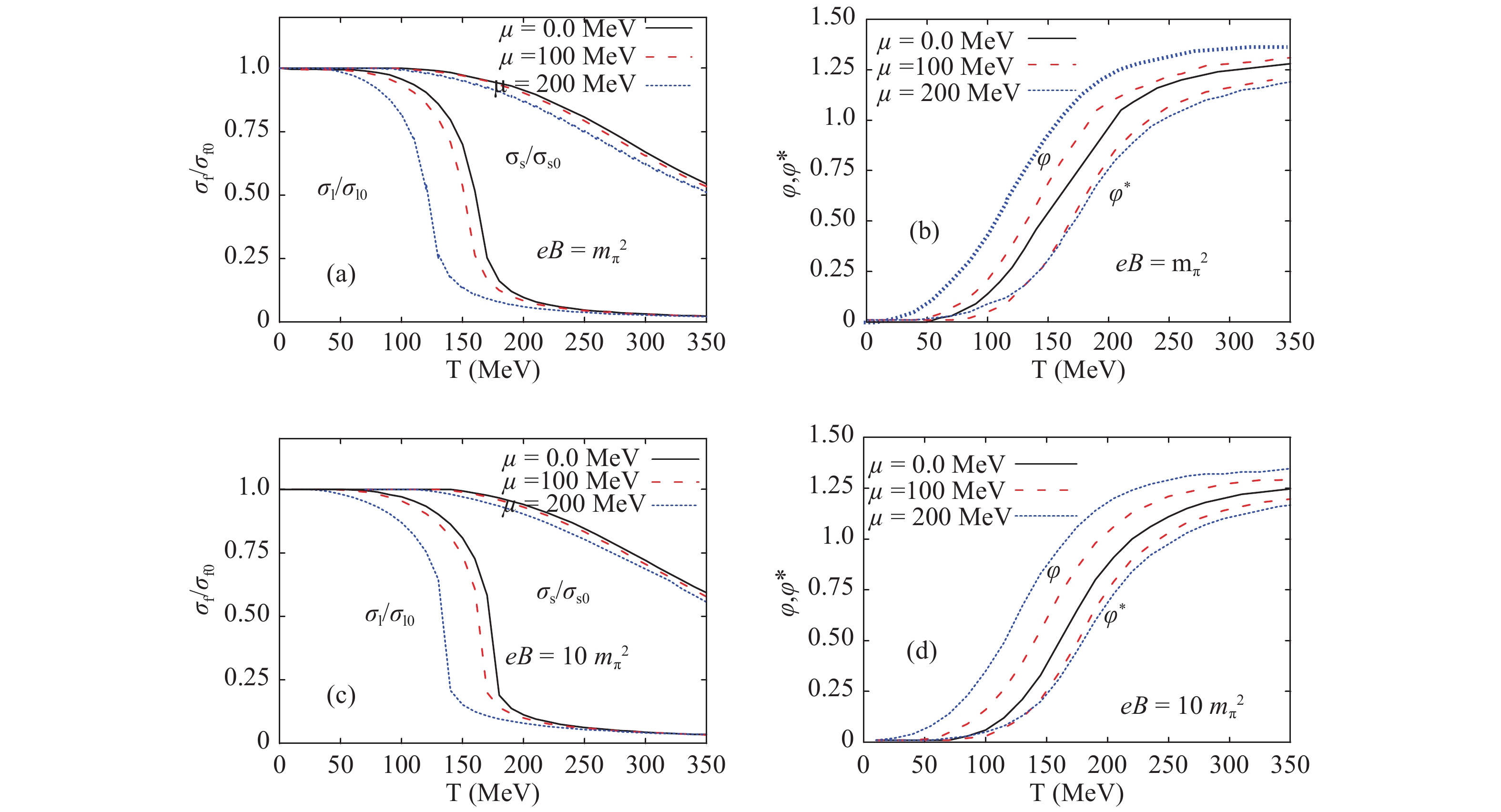 Figure1. (color online) Left-hand panels (a) and (c) show the normalized chiral-condensate with respect to the vacuum value as function of temperature. Right-hand panels (b) and (d) show the expectation value of the Polyakov-loop fields (
Figure1. (color online) Left-hand panels (a) and (c) show the normalized chiral-condensate with respect to the vacuum value as function of temperature. Right-hand panels (b) and (d) show the expectation value of the Polyakov-loop fields (Right-hand panels (b) and (d) show the Polyakov-loop order parameters (
Figure 2 illustrates the temperature dependence of the normalized chiral quark-condensates (a) and deconfinement order parameters (b) for different magnetic fields,
 Figure2. (color online) Left-hand panel: the normalized chiral condensate as function of temperature for a vanishing baryon chemical potential
Figure2. (color online) Left-hand panel: the normalized chiral condensate as function of temperature for a vanishing baryon chemical potential In both figures, we assure that the maximum Landau levels are fully occupied with quark states. The details about the Landau quantization as a crucial consequence of the magnetic field, and how the corresponding levels are occupied with quark states, can be obtained from Refs. [35, 40].
Furthermore, we have calculated the chiral condensates (
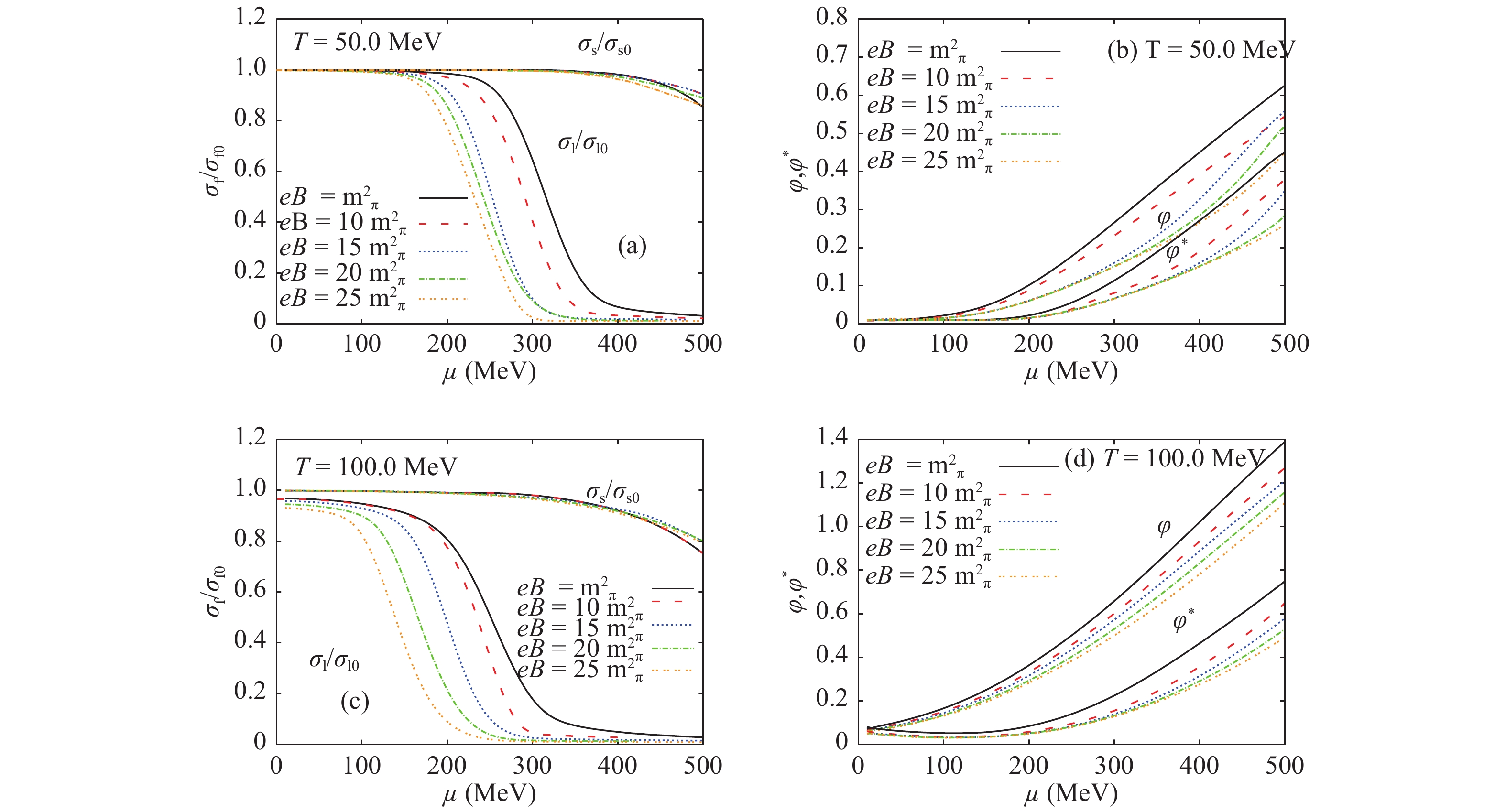 Figure3. (color online) Left-hand panels (a) and (c) show the chiral condensates (
Figure3. (color online) Left-hand panels (a) and (c) show the chiral condensates (We observe that increasing the magnetic field accelerates the rapid decrease in the chiral phase-structure. This leads to a decrease in the corresponding critical chemical potential, which is determined in a similar manner as the critical chiral temperature. Increasing the magnetic field tends to accelerate the phase transition, i.e. to accelerate the formation of a metastable phase characterizing the region of crossover. This phenomenon is known as magnetic catalysis, and is actually an inverse one.
There is a gap difference between the light and strange chiral condensates at high densities. This can be understood because of the inclusion of the anomaly term in Eq. (12), which was discussed in Section 2.2, and is known as the c term. The resulting fit parameters are accordingly modified [8, 11]. This was conjectured as an evidence of the numerical estimation of the chiral condensates. The difference between
The right-hand panels (b) and (d) show the dependence of the deconfinement order parameter on the baryon chemical potential for temperatures
It is obvious that the slope of
In light of our study of the phase structure of PLSM for finite T,
In the present work, we concentrate on a detailed version of the T-eB phase-diagram, Fig. 4. We distinguish between the critical chiral and critical deconfinement temperatures. Also, we confront our calculations to the recent
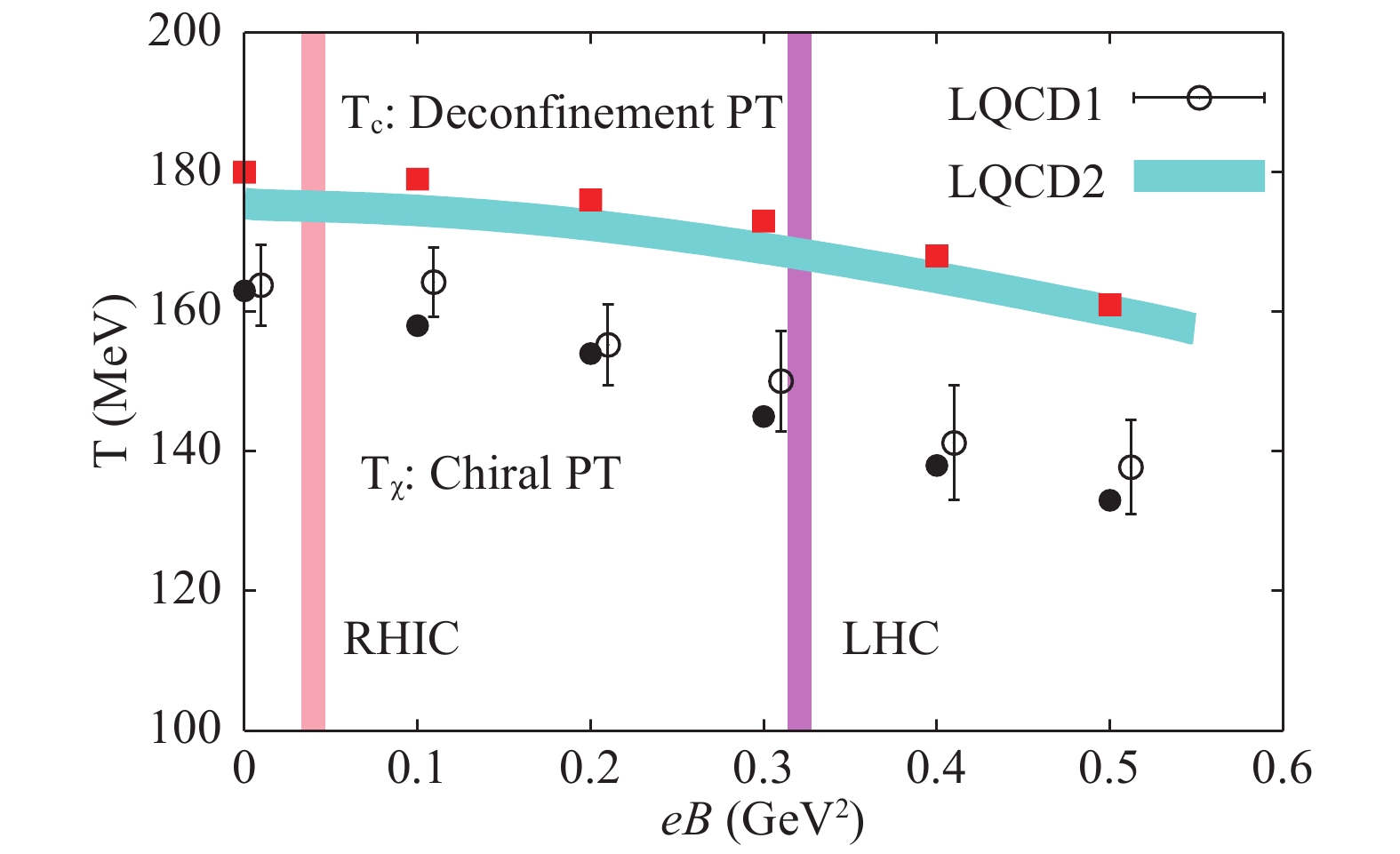 Figure4. (color online) Dependence of the critical chiral and critical deconfinement temperatures on a finite magnetic field determined from PLSM (closed symbols). The results are compared to the recent
Figure4. (color online) Dependence of the critical chiral and critical deconfinement temperatures on a finite magnetic field determined from PLSM (closed symbols). The results are compared to the recent Figure 4 illustrates our PLSM estimations of the dependence of the critical chiral and critical deconfinement temperatures,
We recall that there are at least two different methods that can be utilized to determine the critical temperature. In the first one,
A few remarks concerning the magnetic catalysis are in order. In Eq. (11), the first term,
It is noteworthy to recall that Ref. [46] reported an opposite results, i.e. a direct magnetic catalysis. The first term in the free energy, Eq. (11),
2
3.2.Chiral phase-structure of meson states in a finite magnetic field
In a previous work, sixteen meson states in thermal and dense medium were studied with SU(3) PLSM [11] for a vanishing magnetic field. For a finite magnetic field, an estimation of the magnetic effects on four meson states was presented in Ref. [31]. In order to conduct a systematic study of the effects of the magnetic field strength on nonet (sixteen) meson states, the chiral phase-structure of each meson-state is analyzed depending on temperature, baryon chemical potential and finite magnetic field.● We start with an approximate range for the magnetic field strength that may be created in heavy-ion collisions at RHIC and LHC energies [5-7],
● We then construct the temperature dependence of all meson states corresponding to the lowest Matsubara frequency.
● Last but not least, the chiral phase-structure of the meson states is then given in a wide range of baryon chemical potentials.
In quantum field theory, the hadron mass can be determined from the second derivative of the equation of motion relative to the hadron field of interest. The free energy
$ \begin{aligned} m_{i, ab}^2 = \left. \frac{\partial^2 {\cal{F}} (T, \mu, eB, \beta) }{\partial \beta_{i, a} \partial \beta_{i, b} }\right|_{\rm min}, \end{aligned} $  | (19) |
● The first one is related to vacuum, where the meson masses are derived from the nonstrange (
● The in-medium term, in which the magnetic field is included, reads
$ \begin{split} m_{i, ab}^2 =& \left. \nu_{c}\sum_{f} \frac{|q_f| B T}{(2 \pi)^2} \sum_{\nu = 0}^{\infty} (2-\delta _{0 \nu }) \int_0^{\infty} {\rm d}p_z \right. \\&\times\frac{1}{2E_{B, f}} \biggl[(n_{q, f, B} + n_{\bar{q}, f, B} ) \biggl( m^{2}_{f, a b}-\frac{m^{2}_{f, a} m^{2}_{f, b}}{2 E_{B, f}^{2}} \biggr) \\ & +(b_{q, f, B} + b_{\bar{q}, f, B}) \biggl(\frac{m^{2}_{f, a} m^{2}_{f, b}}{2 E_{B, f} T} \biggr) \biggr], \end{split} $  | (20) |
- The quark mass derivative with respect to the meson fields (
- The quark mass with respect to meson fields (
- Correspondingly, the antiquark function
$ \begin{aligned} b_{q, f, B}(T, eB, \mu_f)= n_{q, f, B}(T, eB, \mu_f) (1-n_{q, f, B}(T, eB, \mu_f)). \end{aligned} $  | (21) |
$ \begin{aligned} n_{q, f, B} =& \frac{\Phi {\rm e}^{- E_{q, f}/T} + 2 \Phi^* {\rm e}^{-2 E_{q, f}/T} + {\rm e}^{-3 E_{q, f}/T}}{1+3(\phi+\phi^* {\rm e}^{-E_{q, f}/T}) {\rm e}^{-E_{q, f}/T}+{\rm e}^{-3E_{\bar{q}, f}/T}}, \end{aligned} $  | (22) |
$ \begin{aligned} n_{\bar{q}, f, B} =& \frac{\Phi^* {\rm e}^{-E_{\bar{q}, f}/T} + 2 \Phi {\rm e}^{-2E_{\bar{q}, f}/T} + {\rm e}^{-3E_{\bar{q}, f}/T}}{ 1+3(\phi^*+\phi {\rm e}^{-E_{\bar{q}, f}/T}) {\rm e}^{-E_{\bar{q}, f}/T}+{\rm e}^{-3E_{\bar{q}, f}/T}}, \end{aligned} $  | (23) |
$ \begin{aligned} c_{{q}, f, B} =& \frac{\Phi {\rm e}^{- E_{q, f}/T} +4 \Phi^* {\rm e}^{-2 E_{q, f}/T} +3 {\rm e}^{-3 E_{q, f}/T}}{1+3(\phi+\phi^* {\rm e}^{-E_{q, f}/T}) {\rm e}^{-E_{q, f}/T}+{\rm e}^{-3E_{\bar{q}, f}/T}}, \end{aligned} $  | (24) |
$ \begin{aligned} c_{\bar{q}, f, B} =& \frac{\Phi^* {\rm e}^{-E_{\bar{q}, f}/T} + 4 \Phi {\rm e}^{-2E_{\bar{q}, f}/T} +3 {\rm e}^{-3E_{\bar{q}, f}/T}}{ 1+3(\phi^*+\phi {\rm e}^{-E_{\bar{q}, f}/T}) {\rm e}^{-E_{\bar{q}, f}/T}+{\rm e}^{-3E_{\bar{q}, f}/T}}. \end{aligned} $  | (25) |
It should noted that due to the mixing between the (pseudo)scalar and (axial)vector sectors through the covariant derivative, the tree-level expressions of the pseudoscalars and some scalars are not mass eigenstates. When the corresponding wave functions are renormalized to the constants Z, such a mixing can be resolved. Details can be found in Ref. [25].
3
3.2.1.Dependence of meson states on temperature
Figure 5 shows the (pseudo)scalar and (axial)vector meson states with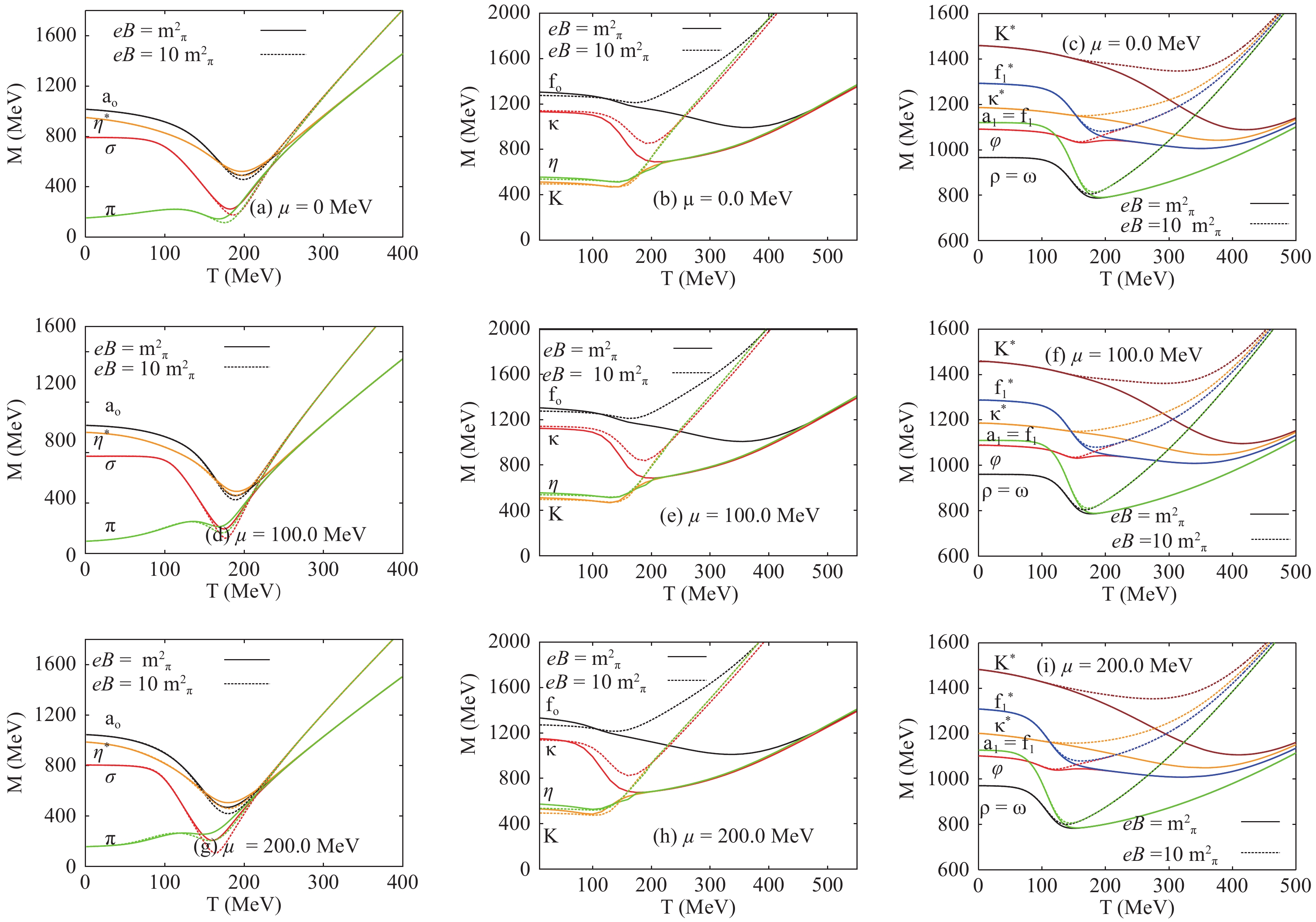 Figure5. (color online) The temperature dependence of (pseduo)scalar and (axial)vector meson states calculated for finite magnetic fields,
Figure5. (color online) The temperature dependence of (pseduo)scalar and (axial)vector meson states calculated for finite magnetic fields, The mass gap between the various meson states can be estimated from the bosonic thermal contributions. The masses of bosons are given as function of pure sigma fields, the nonstrange (
As depicted in Fig. 5, the effects of a finite magnetic field on the thermal contributions of the meson states can be divided into three regions.
● The first region is dominated by the bosonic thermal contributions, and the magnetic field remains ineffective until the second region takes place.
● In the second region, beyond the chiral phase-transition of a given meson state, the influence of the magnetic field becomes obvious. We observe that the increasing magnetic field accelerates the chiral phase-transition of a given meson. By accelerating, we mean that the phase transition takes place at lower temperatures or chemical potentials. As a result, the chiral critical temperature decreases with increasing magnetic field strength.
● The last (third) region represents the fermionic thermal contributions.
We conclude that the magnetic field has an evident effect on quarks and apparently accelerates and sharpens the quark-hadron phase transition.
We observe that at temperatures exceeding the critical values (corresponding to each meson state), the meson masses become degenerate. This can be understood as due to the effect of fermionic fluctuations on chiral symmetry restoration [8], especially on the strange condensate (
Also, Fig. 5 shows that the
Increasing the baryon chemical potential influences the behavior of the thermal contributions of different meson states as well. We find that the increase of the baryon chemical potential (from top to bottom panels) enhances various degenerate meson masses. For example, the
Our goal is not only the characterization of the meson spectra in thermal and dense medium, but also the description of their vacuum phenomenology in a finite magnetic field. In Table 1, an extensive comparison is given of the results for different scalar and vector meson (nonets) from various effective models, PLSM (present work) and PNJL [12-15, 47] , and from the very recent compilation of PDG [48], lattice QCD calculations [49, 50] and QMD/UrQMD simulations [51]. We conclude that our PLSM calculations are remarkably precise, especially for some light mesons at a vanishing temperature. They are comparable with measurements and lattice calculations, as shall be elaborated in the following section.
| sector | meson states | PDG [48] | UrQMD model [51] | present work | PNJL model [12-15, 47] | lattice QCD calculations | |
| Hot QCD[49] | PACS-CS [50] | ||||||
scalar   |   |   |   |   | 837 | ||
  |   | 1429 | 1115 | 1013 | |||
  |   | 800 | 700 | ||||
  |   |   |   | 1169 | |||
pseudoscalar   |   |   |   |   | 126 |   |   |
  |     |   | 509 | 490 |   |   | |
  |   |   | 553 | 505 |   |   | |
  |   |   |   | 949 | |||
vector   |   |   |   | 745 |   |   |   |
  |   |   | 745 |   |   |   | |
  |   |   | 894 |   |   |   | |
  |   |   | 1005 |   | |||
axial-vector   |   |   | 1230 | 980 |   | ||
  |   |   | 980 |   | |||
  |   | 1273 | 1135 |   | |||
  |   | 1512 | 1315 |   | |||
Table1.Comparison of the (pseudo)scalar and (axial)vector meson states obtained in the present work (PLSM), and the corresponding results from PNJL [13-15], the latest compilation of PDG [48], QMD/UrQMD [51] and lattice QCD calculations [49, 50].
Only pseudoscalar and vector meson sectors are available from HotQCD [49] and PACSCS collaborations [50]. It is obvious that our estimations for meson masses agree well with previous calculations [8, 9, 11, 25] for mixing strange with nonstrange scalar states, where it was reported that one gets various states below 1 GeV and one above 1 GeV [25]. The agreement between PLSM and the available lattice-calculations is excellent.
3
3.2.2.Dependence of meson states on baryon chemical potential
Figure 6 shows the dependence of scalar and vector meson states (labeled curves) on the baryon chemical potentials in the presence of the U(1)A anomaly, for magnetic fields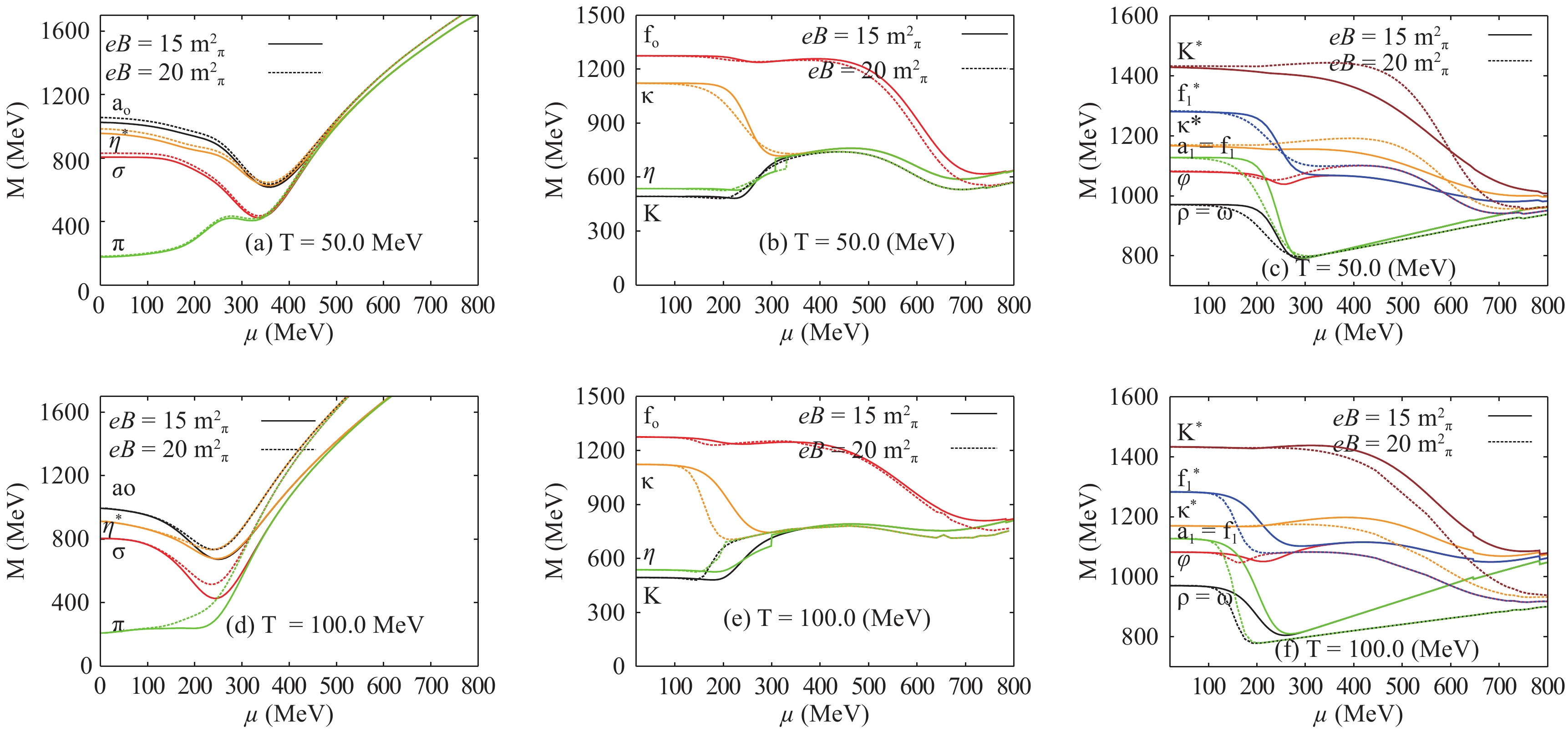 Figure6. (color online) Dependence of the masses of (pseudo)scalar and (axial)vector meson states on the baryon chemical potential for magnetic field strengths
Figure6. (color online) Dependence of the masses of (pseudo)scalar and (axial)vector meson states on the baryon chemical potential for magnetic field strengths Another finding of the present work is that for a fixed magnetic field, the finite baryon chemical potential is conjectured to contribute through baryon density to the masses of various meson states, and is dominant in three regions:
● The first region is characterized by low
● The second region appears when the meson states undergo a chiral phase-transition from confined hadron phase to parton phase, where quarks and gluons dominate the underlying degrees of freedom.
● The third region is characterized by large
As was obtained in the study of the temperature dependence, the dependence of various meson masses on
In the middle panels of Fig. 6, we note that the meson masses reduce in the first-order phase transition. Concretely, the mass of the
In Fig. 6, two independent quantities (T and
3
3.2.3.Meson states normalized to the lowest Matsubara frequency
In thermal field theory, the Matsubara frequencies are considered as a summation over all discrete imaginary frequencies $ \begin{aligned} S_{\pm} =& T \sum_{i \omega_n} g(i \omega_n), \end{aligned} $  | (26) |
$ \begin{aligned} S_{\pm} =& \frac{T}{2 \pi i} \oint g(z) \Gamma_{\eta}(z) {\rm d} z. \end{aligned} $  | (27) |
$ \begin{aligned} \Gamma_{\pm}(z) =& \left\{\begin{array}{l} \eta \displaystyle\frac{1+n_{\pm}(z)}{T} \\ \\ \eta \displaystyle\frac{n_{\pm}(z)}{T} \end{array} \right., \end{aligned} $  | (28) |
The boson masses are conjectured to get contributions from the Matsubara frequencies [54]. Furthermore, at temperatures above the chiral phase-transition (
Figure 7 depicts the normalization of the different meson states with respect to the lowest, in this case bosonic, Matsubara frequency (
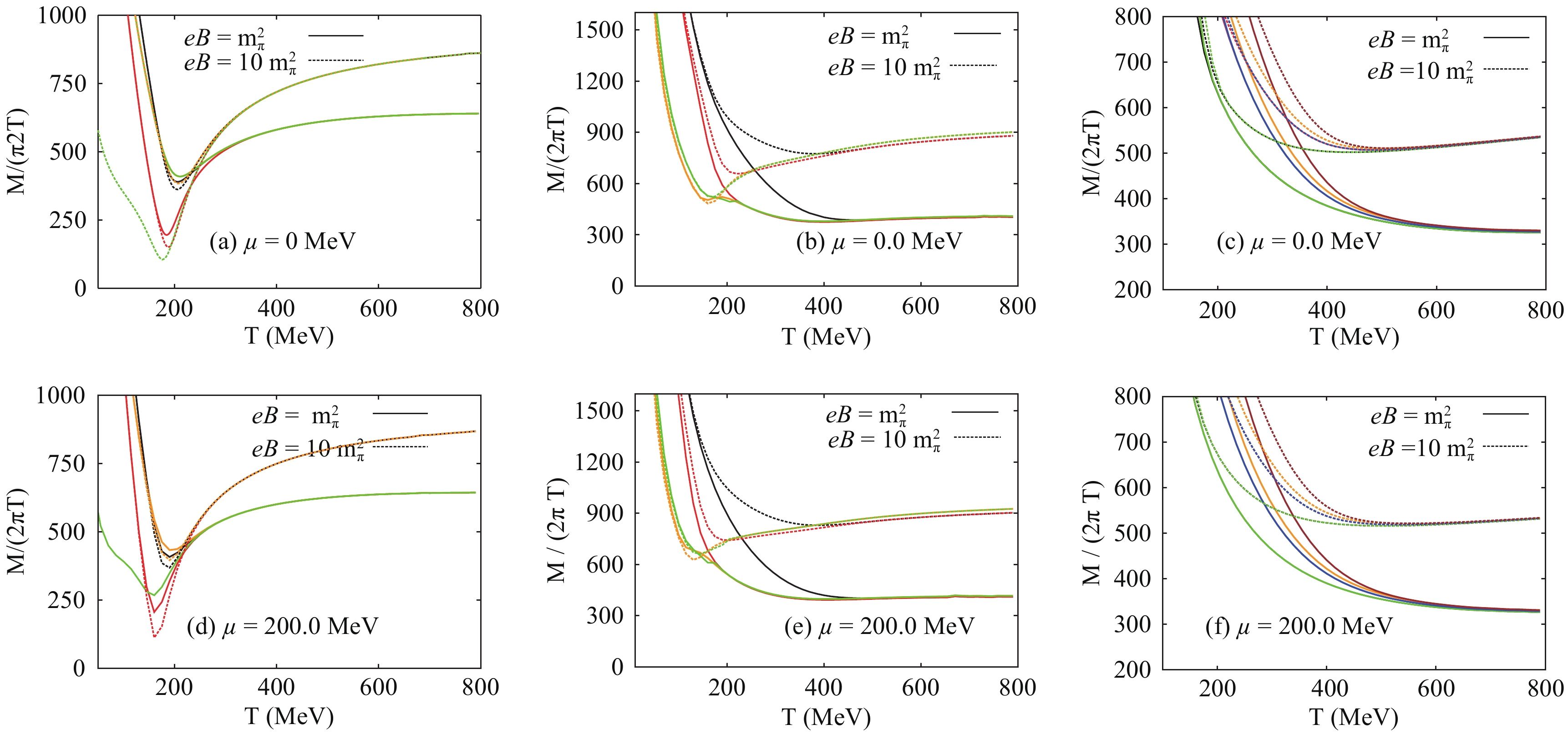 Figure7. (color online) Left-hand and middle panels depict the scalar and pseudoscalar meson sectors, respectively, as function of temperature for vanishing (top panels) and finite baryon chemical potential (bottom panels). The right-hand panel shows the same as in the left-hand panel but for vector and axial vector meson sectors.
Figure7. (color online) Left-hand and middle panels depict the scalar and pseudoscalar meson sectors, respectively, as function of temperature for vanishing (top panels) and finite baryon chemical potential (bottom panels). The right-hand panel shows the same as in the left-hand panel but for vector and axial vector meson sectors.Table 2 summarizes the different meson states and their approximate dissolving critical temperatures (
| comparison | scalar mesons | pseudoscalar mesons | vector mesons | axial vector mesons |
| meson states |   |   |   |   |
  |   |   |   |   |
Table2.Approximate dissolving critical temperatures,
In relativistic heavy-ion collisions, a huge magnetic field is expected. For instance, due to oppositely directed relativistic motion of charges (spectators) in peripheral collisions and/or due to the local momentum-imbalance of the participants in central collisions, a huge magnetic field can be created. To get a picture of its magnitude, we recall that at SPS, RHIC and LHC energies, the strength of such fields ranges between
In the mean-field approximation of PLSM, a grand canonical partition function can be constructed. In order to prepare for the proposed calculations, we have to estimate the temperature dependence of the deconfinement (
In a previous work, we have studied the distribution of Landau levels and showed how they are occupied for finite magnetic field, temperature, and baryon chemical potential [35, 40]. We concluded that the occupation of each Landau level varies with quark electric charge, as well as with temperature and baryon chemical potential. This is assumed to be characterized by the QCD energy scale.
In PLSM with mean-field approximation, the masses can be determined from the second derivative of free energy with respect to the corresponding hadron field, evaluated at its global minimum. We have presented the temperature and chemical potential dependence of sixteen SU(3) meson masses in finite magnetic fields. For a finite magnetic field, the broken chiral-symmetry is assumed to contribute to the mass spectra. We utilize this assumption to define the chiral phase structure of nonet meson sectors as function of temperature and chemical potential. We found that the spectra of meson masses can be divided into three regions.
● At small temperatures and baryon chemical potentials, the first region is related to the bosonic contributions which are apparently stable.
● The second region is the chiral phase transition, which seems to have a remarkable influence related to the finite magnetic field. It is obvious that the finite magnetic field improves, i.e. sharpens and accelerates, the chiral phase transition of a given meson state.
● The third region is characterized by fermionic contributions, which increase with increasing temperature.
We conclude that the thermal bosonic (meson) mass contributions decrease with increasing temperature. The fermionic (quark) contributions considerably increases at high temperatures. At low temperatures, bosonic contributions become dominant and reach a kind of a stable plateaus relative to the vacuum mass of each meson sector. In this temperature limit, the effects of fermionic contributions are negligibly small. It is noteworthy to highlight that the bosonic contributions result in the mass gap between different meson states in thermal and dense medium. With increasing temperature, the fermionic contributions complete the thermal behavior of these states and lead to mass degeneracy at very high temperatures.
From the scalar and vector mesons normalized to the lowest Matsubara frequency, we also conclude that a rapid decrease of their masses is observed as the temperature increases. Starting from the critical temperature corresponding to each meson sector, we find that the temperature dependence almost vanishes. At high temperatures, we note that the masses of almost all meson states become temperature independent, i.e. they construct a kind of a universal line. This is to be seen as a signature of dissolving of confined mesons into colored quarks and gluons. In other words, the meson states undergo different deconfinement phase transitions, i.e. the various hadrons very likely have different critical temperatures. This is one of the essential findings of the present study, to be confirmed by first-principle lattice simulations and ultimately in future experiments.
We have compared our calculations for scalar and vector mesons with the latest compilation of PDG, lattice QCD calculations and QMD/UrQMD simulations, and found that our results are remarkably precise, especially for some light mesons at vanishing temperature. This implies that the parameters of the QCD-like model we have utilized are reliable.
● For scalar meson states, the squared masses for the scalar sector (
$ \tag{A1} \begin{aligned} m^2_{a_0} =& m^2 + \lambda_1 \left( {\bar{\sigma}} _l^2 + {\bar{\sigma}} _s^2\right) + \frac{3 \lambda_2}{2} {\bar{\sigma}} _l^2 +\frac{\sqrt{2} c}{2} {\bar{\sigma}} _s, \end{aligned} $  |
$ \tag{A2} \begin{aligned} m^2_{\kappa} =& m^2 + \lambda_1 \left( {\bar{\sigma}} _l^2 + {\bar{\sigma}} _s^2\right) + \frac{\lambda_2}{2} \left( {\bar{\sigma}} _l^2 + \sqrt{2} {\bar{\sigma}} _l {\bar{\sigma}} _s + 2 {\bar{\sigma}} _s^2\right) + \frac{c}{2} {\bar{\sigma}} _l, \end{aligned} $  |
$ \tag{A3} \begin{aligned} m^2_\sigma =& m^2_{S, {00}} \cos^{2}\theta _S + m^2_{S, {88}}\sin^{2}\theta_S + 2 m^2_{S, {08}} \sin \theta_S \cos \theta_S, \end{aligned} $  |
$ \tag{A4} \begin{aligned} m^2_{f_0} =& m^2_{S, {00}} \sin^{2}\theta _S + m^2_{S, {88}}\cos^{2}\theta_S - 2 m^2_{S, {08}} \sin \theta_S \cos \theta_S, \end{aligned} $  |
$ \begin{aligned} m^2_{S, {00}} =& m^2 + \frac{\lambda_1}{3} \left(7 {\bar{\sigma}} _l^2 + 4 \sqrt{2} {\bar{\sigma}} _{l} {\bar{\sigma}} _{s} + 5 {\bar{\sigma}} _s^2\right) \\&+ \lambda_2\left( {\bar{\sigma}} _l^2 + {\bar{\sigma}} _s^2\right) -\frac{\sqrt{2}c}{3}\left(\sqrt{2} {\bar{\sigma}} _l + {\bar{\sigma}} _s\right), \\ m^2_{S, {88}} =& m^2 + \frac{\lambda_1}{3} \left(5 {\bar{\sigma}} _l^2 - 4 \sqrt{2} {\bar{\sigma}} _{l} {\bar{\sigma}} _{s} + 7 {\bar{\sigma}} _s^2\right) \\&+ \lambda_2\left(\frac{ {\bar{\sigma}} _l^2}{2} + 2 {\bar{\sigma}} _s^2\right) +\frac{\sqrt{2}c}{3}\left(\sqrt{2} {\bar{\sigma}} _l - \frac{ {\bar{\sigma}} _s}{2}\right), \\ m^2_{S, {08}} =& \frac{2 \lambda_1}{3}\left(\sqrt{2} {\bar{\sigma}} _l^2 - {\bar{\sigma}} _l {\bar{\sigma}} _s - \sqrt{2} {\bar{\sigma}} _s^2 \right) \\&+ \sqrt{2}\lambda_2 \left(\frac{ {\bar{\sigma}} _l^2}{2} - {\bar{\sigma}} _s^2 \right) + \frac{c}{3\sqrt{2}} \left( {\bar{\sigma}} _l - \sqrt{2} {\bar{\sigma}} _s\right). \end{aligned} $  |
$ \tag{A5} \begin{aligned} m^2_\pi =& m^2 + \lambda_1 \left( {\bar{\sigma}} _l^2 + {\bar{\sigma}} _s^2\right) + \frac{\lambda_2}{2} {\bar{\sigma}} _l^2 -\frac{\sqrt{2} c}{2} {\bar{\sigma}} _s, \end{aligned} $  |
$ \tag{A6} \begin{aligned} m^2_K =& m^2 + \lambda_1 \left( {\bar{\sigma}} _l^2 + {\bar{\sigma}} _s^2\right) + \frac{\lambda_2}{2} \left( {\bar{\sigma}} _l^2 - \sqrt{2} {\bar{\sigma}} _l {\bar{\sigma}} _s + 2 {\bar{\sigma}} _s^2\right) - \frac{c}{2} {\bar{\sigma}} _l, \end{aligned} $  |
$ \tag{A7} \begin{aligned} m^2_{\eta'} =& m^2_{p, {00}} \cos^{2}\theta _p + m^2_{p, {88}}\sin^{2}\theta _p + 2 m^2_{p, {08}} \sin \theta _p \cos \theta_p, \end{aligned} $  |
$ \tag{A8} \begin{aligned} m^2_{\eta} =& m^2_{p, {00}} \sin^{2}\theta_p + m^2_{p, {88}}\cos^{2}\theta_p - 2 m^2_{p, {08}} \sin \theta_p \cos \theta_p, \end{aligned} $  |
$ \begin{aligned} m^2_{p, {00}} =& m^2 + \lambda_1 \left( {\bar{\sigma}} _l^2 + {\bar{\sigma}} _s^2\right) + \frac{\lambda_2}{3}\left( {\bar{\sigma}} _l^2 + {\bar{\sigma}} _s^2\right) +\frac{c}{3}\left(2 {\bar{\sigma}} _l + \sqrt{2} {\bar{\sigma}} _s\right), \\ m^2_{p, {88}} =& m^2 + \lambda_1 \left( {\bar{\sigma}} _l^2 + {\bar{\sigma}} _s^2\right) + \frac{\lambda_2}{6}\left( {\bar{\sigma}} _l^2 + 4 {\bar{\sigma}} _s^2\right) -\frac{c}{6}\left(4 {\bar{\sigma}} _l - \sqrt{2} {\bar{\sigma}} _s\right), \\ m^2_{p, {08}} =& \frac{\sqrt{2} \lambda_2}{6} \left( {\bar{\sigma}} _l^2 - 2 {\bar{\sigma}} _s^2\right) - \frac{c}{6}\left(\sqrt{2} {\bar{\sigma}} _l - 2 {\bar{\sigma}} _s\right), \end{aligned} $  |
$ \tag{A9} \begin{aligned} \tan 2\theta_i =& \frac{2 m^2_{i, {08}}}{m^2_{i, {00}}-m^2_{i, {88}}}\ , \ i=S, p\ . \end{aligned} $  |
$ \tag{A10} \begin{aligned} m_{\rho}^{2} =&m_{1}^{2}+\frac{1}{2} \left(h_{1}+h_{2}+h_{3}\right) {\bar{\sigma}} _l^{2} +\frac{h_{1}}{2} {\bar{\sigma}} _s^{2}+2\delta_{l}, \end{aligned} $  |
$ \tag{A11} \begin{split} m_{K^{\star}}^{2} =&m_{1}^{2}+\frac{ {\bar{\sigma}} _l^{2}}{4} \left(g_{1}^{2}+2h_{1} +h_{2}\right) \\&+\frac{ {\bar{\sigma}} _l {\bar{\sigma}} _s}{\sqrt{2}}(h_{3}-g_{1}^{2})+\frac{ {\bar{\sigma}} _s^{2}}{2}\left(g_{1}^{2}+h_{1}+h_{2}\right)+\delta_{l}+\delta_{s}, \end{split} $  |
$ \tag{A12} \begin{aligned} m_{\omega_{x}}^{2} =&m_{\rho}^{2}, \end{aligned} $  |
$ \tag{A13} \begin{aligned} m_{\omega_{y}}^{2} &=&m_{1}^{2}+\frac{h_{1}}{2} {\bar{\sigma}} _l^{2} + \left( \frac{h_{1}}{2}+h_{2}+h_{3}\right) {\bar{\sigma}} _s^{2}+2\delta_{s}, \end{aligned} $  |
$ \tag{A14} m_{a_{1}}^{2} =m_{1}^{2}+\frac{1}{2} \left(2g_{1}^{2}+h_{1}+h_{2}-h_{3}\right) {\bar{\sigma}} _l^{2}+\frac{h_{1}}{2} {\bar{\sigma}} _s^{2}+2\delta_{l}, $  |
$ \tag{A15} \begin{split} m_{K_{1}}^{2} =&m_{1}^{2}+\frac{1}{4}\left( g_{1}^{2}+2h_{1}+h_{2}\right) {\bar{\sigma}} _l^{2}-\frac{1}{\sqrt{2}} {\bar{\sigma}} _l {\bar{\sigma}} _s \left(h_{3}-g_{1}^{2}\right) \\&+ \frac{1}{2}\left(g_{1}^{2}+h_{1}+h_{2}\right) {\bar{\sigma}} _s^{2} +\delta_{l}+\delta_{s}, \end{split} $  |
$ \tag{A16} m_{f_{1x}}^{2} = m_{a_{1}}^{2}, $  |
$ \tag{A17} m_{f_{1y}}^{2}=m_{1}^{2}+\frac{ {\bar{\sigma}} _l^{2}}{2} h_{1}+\left(2g_{1}^{2}+\frac{h_{1}}{2}+h_{2}-h_{3}\right) {\bar{\sigma}} _s^{2}+2\delta_{s}. $  |








